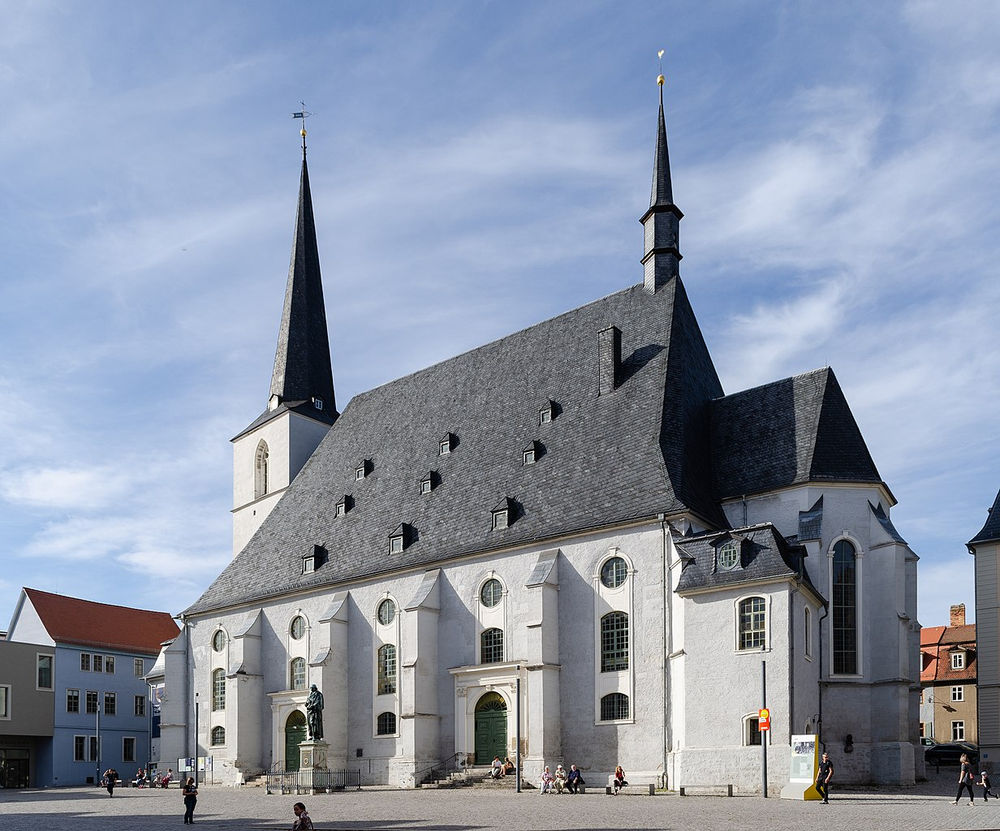Cantata 63, for Christmas Day, dates from Bach’s Weimar period, and he reused it at least a couple of times during his tenure in Leipzig with minor modifications.
Its orchestration of 4 trumpets, timpani, 3 oboes and bassoon, strings, 4-part choir and basso continuo is too large for the small ducal chapel where Bach usually performed his cantatas in Weimar – which suggests that he used a different venue for the original 1714 performance, probably the much bigger Peter and Paul Church.
In addition to the unusually big orchestration, the libretto is also somewhat peculiar. As Alfred Dürr points out, this cantata contains none of the typical Christmas imagery – no shepherds, no angels, no traditional Christmas chorales. Instead, it’s a musical setting of a poem (possibly by Johann Michael Heineccius) which revolves around the arrival of Christ to redeem “a fallen people” and free it from the “captivity and chains of servitude to Satan”.
Bach organizes the cantata symmetrically. The center of the structure is movement 4 (of 7) – a tenor recitative which represents the rhetorical inflection point as it announces that our suffering will be changed into joy and grace by the “Lion of the stem of David”. Moving outwards from this center movement are two duets, further out two accompanied recitatives, and the outside movements are choral pieces with the full orchestra. Except for the opening chorus, the movements in the first half of the cantata are somber and contemplative, while the ones after the inflection point are animated and optimistic in nature.
The cantata opens with a majestic choral fantasia, in triple dance-like tempo and da-capo form, as a call to celebrate the birth of Jesus – “Christians, engrave this day / In metal and marble stones!” The three instrumental ensembles (trumpets, reed band and strings) alternate the rapid, ascending motif in 16th notes, full of festive energy.
The following recitative, for the alto accompanied by strings, is of considerable length, and goes back and forth into arioso to underline key expressions (like “rescue Israel from […] slavery to Satan” or the “blessed decree” of Jesus’ birth).
The duet that follows, in da-capo form, is for soprano and bass. Set in a slow and contemplative tempo, with a very ornamental oboe solo swirling around the voices, it discusses the believer’s confidence in God’s designs, which will provide us eternal delight.
At this point we get to the inflection point, with the tenor “secco” recitative mentioned before. The recitative turns into arioso at the mention of “salvation and grace”. Then, the image of the Lion of Judah (“Der Löw aus Davids Stamme”) is underscored by rapid and energetic scales on the continuo line to illustrate his bow and sword.
In stark contrast with the mood of the first half, the next movement, again a duet (for alto and tenor this time) is dance-like, in triple tempo, and features a vigorous string accompaniment. The sung parts are frequently in canonic imitation to each other, reinforcing the idea of coming together to thank God. The dance character is actually prompted in the text (“komm zum Reihen”, “come to the dance”). Bach word-paints “Reihen” using long melismas in both voices. In the “B” section, the repeated notes highlight the concept of “danken” (“thanking”).
This leads to the next accompagnato recitative, set for the bass with strings and oboes, which incorporates some nice word painting on the words “Steigt fröhlich himmelan” (“Rise joyfully to heaven”). The recitative turns into arioso on the last line, to highlight the concept of giving thanks to God.
The cantata closes with another energetic and sparkling choral movement with the whole orchestra. To open, upbeat fanfares and rapid 32nd note passages in the instrumental groups lead to homophonic interventions of the choir. The texture quickly changes to resemble a motet, in which the voices begin “a cappella” and soon are doubled by the instruments, progressively creating a larger and larger sound. Additional fanfares then lead to the “B” section, which features a remarkable illustration of Satan via chromatically descending scales in all voices, before looping around “da capo” to close triumphally.

